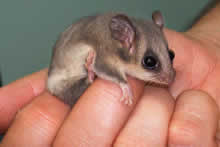Eastern pygmy possum tracked in south coast forests
Note: This content is stored on an archive website and may not be current or accurate. Contact us to clarify.
An eastern pygmy possum has been trapped and fitted with a radio collar by researchers at State Forests South East Regional office at Eden in order to gain information on its habitat use.
Eastern pygmy possums have recently been listed as threatened on the Threatened Species Conservation Act (1995).
The project is being coordinated in conjunction with Dr Brad Law from State Forests Research and Development branch based at Sydney and giant burrowing frog PhD student Mr Trent Penman.
State Forests regional ecologist Mr Chris Slade said the project planned to monitor a number of eastern pygmy possums for up to two years, with this particular eastern pygmy possum being tracked, hopefully, for a month.

Female pygmy possum
“The information will be used to provide valuable information on habitat use and home range size to better inform forest managers in planning protection measures.
“It is also planned to look at burning and logging effects on eastern pygmy possums by monitoring before, during and after these management activities,” he said.
Mr Slade said the eastern pygmy possum was trapped in a pit fall trap in Bloodwood (Corymbia gummifera) dominated forest within Nullica State Forest.
“The initial movement tracked was about 160 metres in one night to a small Bloodwood with the most likely hollowused as a den being a small dead branch with an old borer hole.
“Other den sites also used include several stumps and a fallen branch,” he said.
Eastern pygmy possums are small nocturnal arboreal mammals that eat nectar, pollen and insects.
They weigh on average 24 grams, have light brown/grey fur and are approximately 10 centimetres in length.
They occur in south eastern Australia, Queensland, NSW and Victoria in a relatively narrow strip of land adjacent to the coast.
Media contact: Chris Slade on (02) 6496 1500.

